|
|
 |
|
INDEX
WHO DID DISCOVER AUSTRALIA?
COLONIAL EXPLORATION |
Dutch Exploration: Discoveries and Encounters 1650 onwards | 1606 - 1619 | 1620 - 1650 Pieter Albertsz (Vergulde Draeck) 1656 Vergulde Draeck (also known as Gilt Dragon) was purchased by the Amsterdam Chamber of the Dutch East India Company in 1653, and its first trading voyage was between Holland and the East Indies. On 4th October 1655, under the command of Pieter Albertsz, she set sail for Batavia. Aboard was a crew of 193 men, eight chests of silver coin worth 78 600 guilders and a cargo of trade goods worth 106,400 guilders.
The English translation of the documents relating to the Vergulde Draeck gave rise to much speculation as to the whereabouts of the vessel and its valuable cargo. In 1931 Alan Edwards discovered 40 silver coins in the sand-hills just north of Cape Leschenault. The wreck was not found, however, until 14th April 1963 by a group of spear fishermen. Little remains of the ship itself, however many objects have been removed by the WA Museum from the wrecksite and are on display at the WA Maritime Museum, Frementle. Related websites: WA Museum | Ships of the World: Vergulde Draeck | VOC shipwrecks (Witte Valke, Goede Hoop) 1656 The jacht Goede Hoop and the fluit Witte Valke were sent from Batavia to look for survivors of the Vergulde Draeck after the arrival there of seven crew in a boat from the wrecksite in June 1656. Violents storms encountered made locating the wreck and any rescue of survivors impossible. Several other expeditions were mounted in the following year, but all failed to turn up any of the missing crew, although some wreckage was noted in the region of Fremantle. (Vinck) 1657 The flute Vinck sailed from the Cape to Batavia with orders to call at New Holland and search for survivors of the Vergulde Draeck. Once again there was no success, primarily due to bad weather and rough seas. Samuel Volkerson (Waeckende Boey and Emeloort) 1658
Jacob Pieterszoon Peereboom (Elburgh) 1658 Captain Peereboom explored the region north of Cape Leeuwin in the Elburgh. A landing party found some Aborigines who fled on their arrival. Peereboom reported having been at anchor "in Lat. 33° 14' South, under a projecting point", which was probably Cape Naturaliste. Jan van der Wall (Vliegende Swaan) 1678 Explored and charted the northwest coast of New Holland in his VOC ship Vliegende Swaan from present-day Dampier to the Exmouth Gulf. (Ridderschap van Holland) 1694 The Riddershap van Holland (Nobility of Holland) disappeared on a voyage from the Cape of Good Hope to Batavia. This vessel belonged to the largest class of the company's ships, 45.3 metres long, with a nominal carrying capacity of 520 tonnes. The passengers on its fifth and final voyage to the Indies included a senior VOC official, Sir lames Couper (originally from Scotland), who was scheduled to take up an appointment as a member of the Council of the Indies in Batavia. The ship disappeared after leaving the Cape of Good Hope, bound for Batavia, on 5 February 1694. Early conjecture was that the vessel, like the Batavia and the Vergulde Draeck before, had probably been wrecked on the coast of the South Land. Its wreck has never been found. Rumours were later received at the Cape to the effect that it had been taken by pirates based at Fort Dauphin, near the south-eastern corner of Madagascar. Even so, there was still hope that survivors could be found, and in 1699 two ships visiting Madagascar sought to establish the fate of the missing vessel, but without success. Wreckage and other relics seen in the southern (Pelsaert) group of the Houtman Abrolhos by survivors of the Zeewijk in 1727, and by Stokes of HMS Beagle in 1840, could well have been derived from the Fortuin, which had disappeared a little more than three years earlier. Alternatively, they could have been from the Riddershap van Holland. Nothing remains of the wreckage and relics at the site described by Stokes today. Related websites: VOC shipwrecks Willem de Vlamingh (Geelvinck, Nijptangh and Weseltje) 1696
An expedition of three ships was dispatched by the Amsterdam Chamber of the VOC to look for the Ridderschap van Holland and explore New Holland further. A new ship was built, a comfortable frigate that would serve as flagship of the Commander - Willem de Vlamingh. It was named Geelvinck after Joan Geelvinck, member of the Board. The Geelvinck would be accompanied by the Nijptang, with Gerrit Collaert as Skipper, and the Wezeltje, with Laurens Theuniszoon Zeeman as Skipper. The latter died en route and was replaced by Cornelis de Vlamingh (the son of Willem). Willem de Vlamingh (born 1640) was the son of Hessel Dirckszoon and Trijntje Cornelis on the island of East-Vlieland in the Netherlands. Because part of the Vlielanders livelihood was whaling, his early seafaring experience had been on whale boats. He married Willempie Cornelis in December 1668 and settled in Amsterdam and its seafaring ways. In 1688, he joined the VOC and on 26th November of that year he was on his way to Batavia for the first time. In 1695, after a few voyages to the East Indies, he was back in Amsterdam and was nominated for the responsible task of mounting an expedition to search for the Ridderschap van Holland. De Vlamingh set sail on 3rd May 1696, sailing north of Scotland into the Atlantic Ocean. Visiting the island Tristan da Cuhna, the Cape of Good Hope, St Paul and Amsterdam before setting sail for New Holland, his three ships reached the New Holland coast on Christmas Eve 1696 somewhere in the vicinity of present day Bunbury. They arrived at Rottnest Island five days later, making it their base for surveys of the area over the next few weeks. de Vlamingh called it Rat's Nest (Rottnest) Island because of the rat-like marsupials named quokkas he found there. Two expeditions were made to the mainland, the first landing at Cottesloe Beach and travelling overland via Lake Monger to the Swan River. A second expedition of three boats led by Vlamingh himself travelled up the river past the site of the City of Perth as far as present day Guildford. L Right: Vlamingh's plate The Lands Welvaren took de Vlamingh's report to Holland as well as the eleven drawings done by Victor Victorszoon, Dirck Hartogh's plate, a box with sea shells, fruits and vegetation which de Vlamingh had gathered and a bottle of oil, extracted from the exquisite smelling wood found on Rottenest were also sent. Some black swans were also sent to Holland but they had died on the journey. For the Board of the VOC the results must have been disappointing although that was due more their own high expectations than de Vlamingh’s failure. What was not there, could not be found. Relared websites: Vlamingh's Voyage to the Southland Maarten van Delft (de Vossenbosch, Waaier and Nova Hollandia) 1705 Three ships - de Vossenbosch, Waaier and Nova Hollandia - under the command of Commander Maarten van Delft explored the Gulf of Carpentaria and the northern coast of New Holland. Marinus Wijsvliet (Zuytdorp) 1712
In 1927 a wreck, later identified as the Zuytdorp, was found by a combined Aboriginal/European family group who were fencing and trapping dingoes on a remote cliff top (right) on the border of Tamala and Murchison House stations north of Geraldton, Western Australia. Their leader was the well known and almost legendary stockman, the late Tom Pepper. He and his family found evidence of large camp fires, broken bottles, coins, cooking pots, masts, rolls of lead, breech blocks (the firing mechanism for small bronze swivel guns) and other material on the cliff top and on the reef platform below. The remains were of such a variety that there appears little doubt that one or two camps had been made by survivors of a the wreck. The only real clues as to its identity were the dates on the coins, the latest being 1711, but this meant little to the small band and the find was kept a close secret.Tom Pepper finally made the discovery known to the authorities over a decade later.
Related websites: Zuytdorp | Possible survivors' story | VOC shipwrecks Jacob Roggeveen (Arena / Tienhoven / Afrikaanse Galei) - 1722 In September 1676, Argent Roggeveen, a man of diverse professions and interests, was commissioned to embark on an expedition to explore the Southland but a lack of funds due to the Anglo-Dutch War saw it shelved. His son Jacob, a law graduate, who had become a man of wealth as Councillor of Justice in Batavia, revived his father's dream at the age of 62, equipping three ships for the enterprise with the help of the VOC's sister business, the Dutch West India Company (WIC). They began their voyage on 26 July 1721 and sailed around Cape Horn and into the Pacific. It must be pointed out that the Southland Roggeveen was seraching for was not the one the Dutch knew well as New Holland, but another Southland believed to be to the east of New Holland somewhere north or north east of Van Diemen's Land.
Roggeveen entered the Tuamoto atolls with his three ships, one of which was wrecked on the windward side of the atoll of Takapoto. Five men deserted and may have repaired the vessel well enough to reach the island of Anna. Iron cannon were still visible on Takapoto in the 1830s. John Byron, who reached the Tuamoto atolls in June 1765, landed at Takaroa, and found the carved head of a Dutch long-boat's rudder, hammered iron and well worn tools. He later wrote that the inhabitants seemed `prodigiously fond of iron.' Ill heath caused Roggeveen to head home via the coasts of New Guinea and Batavia. On his arrival at Batavia, Gov. General Zwaardercroon believed Roggeveen had violated the VOC monopoly and confiscated Roggeveen's ships, sold their cargo and sent their crews home. The WIC complained bitterly over the VOC's actions who were forced by the States General to pay damages and the crew's trip from Batavia. Related websites: Discovery of Easter Island by Roggeveen Fortuyn (1724) Like the Ridderschap van Holland, Fortuyn was a large vessel. She was built in 1722 for the Amsterdam chamber of the United Dutch East India Company. In the company of a small flotilla the ship left the island of Texel, north of the Netherlands, on 27th September 1723 bound for Batavia, via the Cape of Good Hope on her maiden voyage. She departed the Cape of Good Hope for Batavia in a convoy of East Indiamen on 18th January 1724. The other ships in the flottila arrived at Batavia on 1st, 17th April and 21 April 1724 respectively, but Fortuyn never reached its destination and was never seen or heard of again. No wreckage or survivors were ever found. Aagtekerke (1726) The Asgtekerke was a 280 tonne East Indiaman constructed in 1724 for the Zeeland Chamber of the Dutch East India Company. Commanded by Jan Witboon it had a crew of 200 men. The cargo consisted of merchandise and a consignment of bullion and specie amounting to about 200,000 guilders. After departing Cape Town on the 29th January 1726, the Aagtekerke sailed into oblivion. Also a large company vessel, no survivors lived to tell the tale. It’s route could have possibly wrecked it on the coast of Western Australia. There is some evidence from the crew of the wrecked ship Zeewyk that Aagtekerke may have been wrecked on the Abrolhos Islands because they found some remains of what they believed to have been a Dutch vessel that had been wrecked before them. This wreckage has never been found again in recent times and Related website: WA Museum Jan Steyns (Zeewijck) 1727
The Zeewyjk is believed to be the last VOC ship to be wrecked on the Australian coast. The wreck was found by divers of the Royal Australian Navy in 1952. Subsequent dives and expeditions by the WA Museum has removed all artifacts from the wrecksite, some of which are on display at the WA Maritime Museum in Fremantle and the Geraldton Maritime Museum. Several skeletons of persons from the Zeewijk who perished during their sojourn on Gun Island have also been exhumed. Related websites: Zeewijk | VOC shipwrecks Lavienne Lodewijk van Asschens (Rijder, Buis) 1756 The ships Rijder, with Captain Jean Gonzal, and Buis, skippered by Captain Lavienne Lodewijk van Asschens, further explored the Gulf of Carpentaria making landfall a number of times. RELATED WEBSITES
|
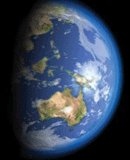
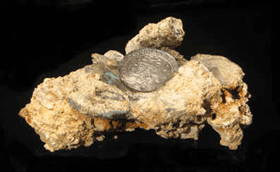 Following the Brouwers route, Vergulde Draeck left the Cape of Good Hope, however, without the ability to establish longitude and distance with any accuracy, the vessel struck a reef off the Western Australian coast north of Yanchep, near Ledge Point, on the morning of 28 April 1656. The vessel began to break up immediately. Two of the ship's boats were launched but only 75 of the crew were able to make it to shore, along with a few of the provisions and stores. Seven of the crew were immediately dispatched to seek assistance in Batavia, while Albertsz and the rest of the crew remained behind. 41 days later, with news of the wreck, the jacht Goede Hoop and the fluit Witte Valke left Batavia in search of survivors. Several other expeditions were mounted in the following year, but all failed to turn up any of the missing crew.
Following the Brouwers route, Vergulde Draeck left the Cape of Good Hope, however, without the ability to establish longitude and distance with any accuracy, the vessel struck a reef off the Western Australian coast north of Yanchep, near Ledge Point, on the morning of 28 April 1656. The vessel began to break up immediately. Two of the ship's boats were launched but only 75 of the crew were able to make it to shore, along with a few of the provisions and stores. Seven of the crew were immediately dispatched to seek assistance in Batavia, while Albertsz and the rest of the crew remained behind. 41 days later, with news of the wreck, the jacht Goede Hoop and the fluit Witte Valke left Batavia in search of survivors. Several other expeditions were mounted in the following year, but all failed to turn up any of the missing crew. Abraham Leeman van Santwitz was an Englishman from the town of Sandwich, who joined the Dutch East India Company in the 17th Century, with many others from various countries. On 1st January 1658 Leeman sailed from the Java port of Batavia as uppersteersman”(navigator and 1st officer) on the Dutch sailing ship Waeckende Boey, which was sent with another, smaller ship, the Emeloort, to search for the 68 survivors of the Vergulde Draeck (Gilt Dragon) which had been wrecked off the western coast of New Holland in April 1656. The Waeckende Boey and the Emeloort became separated on their voyage from Batavia to the WA coast, and the Waeckende Boey came in near Rottnest Island on 23rd February 1658 and then turned north. Somewhere near Yanchep, Leeman went ashore with 13 sailors in the ship’s boat to begin the search for the Vergulde Draeck castaways. They stayed ashore overnight and walked up the beach, and soon found wreckage obviously washed ashore from the shipwreck.
Abraham Leeman van Santwitz was an Englishman from the town of Sandwich, who joined the Dutch East India Company in the 17th Century, with many others from various countries. On 1st January 1658 Leeman sailed from the Java port of Batavia as uppersteersman”(navigator and 1st officer) on the Dutch sailing ship Waeckende Boey, which was sent with another, smaller ship, the Emeloort, to search for the 68 survivors of the Vergulde Draeck (Gilt Dragon) which had been wrecked off the western coast of New Holland in April 1656. The Waeckende Boey and the Emeloort became separated on their voyage from Batavia to the WA coast, and the Waeckende Boey came in near Rottnest Island on 23rd February 1658 and then turned north. Somewhere near Yanchep, Leeman went ashore with 13 sailors in the ship’s boat to begin the search for the Vergulde Draeck castaways. They stayed ashore overnight and walked up the beach, and soon found wreckage obviously washed ashore from the shipwreck.  Leeman showed the 13 sailors how to use bush timber, sea lion skins and other makeshift materials to get the boat ready to sail more than 1400 miles home to Java. He rationed the water but there was not enough and some of the people died at sea during the three weeks’ voyage. Some of the sailors swam ashore and deserted on the South Java coast, and the boat was wrecked the next day. Leeman and the three remaining loyal sailors had to start walking overland. It was another five months before they reached the Dutch East India Company settlement of Japara, east of Batavia, as four ragged wretches, almost dead.
Leeman showed the 13 sailors how to use bush timber, sea lion skins and other makeshift materials to get the boat ready to sail more than 1400 miles home to Java. He rationed the water but there was not enough and some of the people died at sea during the three weeks’ voyage. Some of the sailors swam ashore and deserted on the South Java coast, and the boat was wrecked the next day. Leeman and the three remaining loyal sailors had to start walking overland. It was another five months before they reached the Dutch East India Company settlement of Japara, east of Batavia, as four ragged wretches, almost dead. 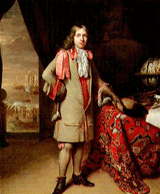 For VOC Board member Nicolaas Witsen the loss of the Ridderschap van Holland was the opportunity he had waited for. He had been aware that since Abel Tasman's journey in 1644 - nearly fifty years before - no serious attempt had been initiated by the VOC to further explore New Holland. He had tried a number of times to convince his fellow Board members of the need for such exploration but to no avail. The loss of the Ridderschap van Holland presented him with an opportunity to push for an inquiry and a thorough search of this area of ocean - i.e. the west coast of the Southland. As the fortunes of the Company were now a major issue his colleagues were more ready to listen.
For VOC Board member Nicolaas Witsen the loss of the Ridderschap van Holland was the opportunity he had waited for. He had been aware that since Abel Tasman's journey in 1644 - nearly fifty years before - no serious attempt had been initiated by the VOC to further explore New Holland. He had tried a number of times to convince his fellow Board members of the need for such exploration but to no avail. The loss of the Ridderschap van Holland presented him with an opportunity to push for an inquiry and a thorough search of this area of ocean - i.e. the west coast of the Southland. As the fortunes of the Company were now a major issue his colleagues were more ready to listen. 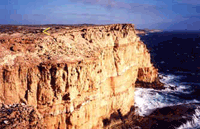 The VOC ship Zuytdorp was lost without trace in the winter of 1712 whilst on a voyage from Holland to Batavia. The wreck is now known to lie on the cliffs just south of Shark Bay of Western Australia named after the wreck. Of the seven East India ships known to be lost off the coast of Western Australia, the Zuytdorp is the only wreck from which survivors did not reach the nearest European settlement at Batavia to tell the tale. This makes it unique and renders the remains on the seabed and on the shore nearby even more significant, as they hold the only know clues to the circumstances of the wreck and to the fate of the ship's passengers and crew.
The VOC ship Zuytdorp was lost without trace in the winter of 1712 whilst on a voyage from Holland to Batavia. The wreck is now known to lie on the cliffs just south of Shark Bay of Western Australia named after the wreck. Of the seven East India ships known to be lost off the coast of Western Australia, the Zuytdorp is the only wreck from which survivors did not reach the nearest European settlement at Batavia to tell the tale. This makes it unique and renders the remains on the seabed and on the shore nearby even more significant, as they hold the only know clues to the circumstances of the wreck and to the fate of the ship's passengers and crew. It was not till 1964 and nearly forty years after the wreck was first found that the first successful dives were undertaken in the area as the site is remote and safe to dive on just a few days of the year. The wreck lay against the reef platform immediately opposite the remains found on the land leaving its discoverers to believe that the ship had either crashed into the base of the cliffs without warning, or if the cliffs had been seen anchors were let go but despite every effort, the ship was still blown ashore. The latter appears most likely as only a few anchors have been found on the wrecksite. In such a case, survivors - most likely the high ranking officers - could have got off the wreck but had been unsuccessful in making the small boat voyage to Batavia and safety. A wide variety of artifacts including many silver coins have been recovered from the wrecksite over the years, many of which are on display at the WA Maritime Museum, Fremantle.
It was not till 1964 and nearly forty years after the wreck was first found that the first successful dives were undertaken in the area as the site is remote and safe to dive on just a few days of the year. The wreck lay against the reef platform immediately opposite the remains found on the land leaving its discoverers to believe that the ship had either crashed into the base of the cliffs without warning, or if the cliffs had been seen anchors were let go but despite every effort, the ship was still blown ashore. The latter appears most likely as only a few anchors have been found on the wrecksite. In such a case, survivors - most likely the high ranking officers - could have got off the wreck but had been unsuccessful in making the small boat voyage to Batavia and safety. A wide variety of artifacts including many silver coins have been recovered from the wrecksite over the years, many of which are on display at the WA Maritime Museum, Fremantle.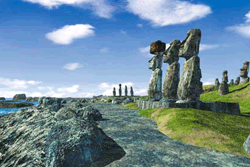 As Roggeveen did not travel as far east as Cook was to travel 48 years later, he did not discover Australia's east coast, rather a number of South Pacific islands including American Samoa and Easter Island. American Samoa was later named the Island of the Navigators by French explorer de Bougainville. On Easter Sunday 1722, Easter Island's 1400 years of isolation ended when Roggeveen sighted a low flat island. The next morning they noted smoke rising from various locations on the island but stood out to sea due to bad weather. The following day a naked, bearded islander came out to one of the ships in a canoe. He was enthralled by the construction of the Dutch ship. Finally the Dutch made it ashore for a quick look around. They were amazed by the large statues which they thought were made of clay (right). The equally amazed Rapa Nui brought them some bananas and chickens, following an unfortunate slaughter of some 9 or 10 islanders who were shot by nervous Dutch sailors.
As Roggeveen did not travel as far east as Cook was to travel 48 years later, he did not discover Australia's east coast, rather a number of South Pacific islands including American Samoa and Easter Island. American Samoa was later named the Island of the Navigators by French explorer de Bougainville. On Easter Sunday 1722, Easter Island's 1400 years of isolation ended when Roggeveen sighted a low flat island. The next morning they noted smoke rising from various locations on the island but stood out to sea due to bad weather. The following day a naked, bearded islander came out to one of the ships in a canoe. He was enthralled by the construction of the Dutch ship. Finally the Dutch made it ashore for a quick look around. They were amazed by the large statues which they thought were made of clay (right). The equally amazed Rapa Nui brought them some bananas and chickens, following an unfortunate slaughter of some 9 or 10 islanders who were shot by nervous Dutch sailors. 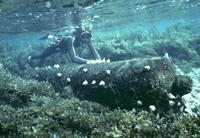 The Zeewijk was constructed for Zeeland Chamber of the Dutch East India Company in 1725. The vessel, commanded by Jan Steyns and a crew of 212, departed for Batavia on 7th November 1726, with a cargo of 315,836 guilders in ten chests. Zeewijck was wrecked on Half Moon Reef in the Abrolhos Islands group on 9th June 1727. The sailor on lookout had sighted the surf breaking a full half-hour earlier, but thought it to be a reflection from the moon. Following the wrecking the crew accused the skipper of going too close to the coastline, not listening to the steersmen and disobeying orders from The Company. The vessel did not break up immediately, but due to the heavy swell washing over the ship it was more than a week before the longboat could be launched. Most of the people were taken to safety to nearby Gun Island. On 10th July, the longboat set sail for Batavia under the command of the uppersteersman, Peter Langeweg, with eleven others who were generally regarded as the most capable of the seamen. They were never heard of again. The survivors who remained managed to salvage all ten money chests from the wreck, taking them to Gun Island. This was a remarkable feat, given the disintegrating state of the wreck and the fact that the total weight of the chests was more than 3 tonnes. The survivors of the wreck lived on the Abrolhos for about 10 months, and during excursions in search of water explored a number of the islands in the southern group.
The Zeewijk was constructed for Zeeland Chamber of the Dutch East India Company in 1725. The vessel, commanded by Jan Steyns and a crew of 212, departed for Batavia on 7th November 1726, with a cargo of 315,836 guilders in ten chests. Zeewijck was wrecked on Half Moon Reef in the Abrolhos Islands group on 9th June 1727. The sailor on lookout had sighted the surf breaking a full half-hour earlier, but thought it to be a reflection from the moon. Following the wrecking the crew accused the skipper of going too close to the coastline, not listening to the steersmen and disobeying orders from The Company. The vessel did not break up immediately, but due to the heavy swell washing over the ship it was more than a week before the longboat could be launched. Most of the people were taken to safety to nearby Gun Island. On 10th July, the longboat set sail for Batavia under the command of the uppersteersman, Peter Langeweg, with eleven others who were generally regarded as the most capable of the seamen. They were never heard of again. The survivors who remained managed to salvage all ten money chests from the wreck, taking them to Gun Island. This was a remarkable feat, given the disintegrating state of the wreck and the fact that the total weight of the chests was more than 3 tonnes. The survivors of the wreck lived on the Abrolhos for about 10 months, and during excursions in search of water explored a number of the islands in the southern group. 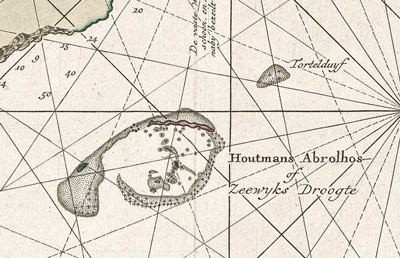 By the end of October 1727, the Zeewijk castaways concluded that the longboat could not have reached Batavia, as they figured a relief ship would have appeared by then. They made the courageous decision to construct a small ship from the wreckage of the Zeewijk with the objective of sailing it to Batavia. The keel of this new vessel, which they named the Sloepie (Little Sloop), was laid on 7th November. It had to be large enough to carry eighty-eight men, over 3 tonnes of coinage, and several tonnes of water and provisions, as well as being sufficiently seaworthy to make the voyage from the Houtman Abrolhos to Batavia. The Sloepie was completed in a little over four months, an amazing achievement, considering the extraordinarily difficult circumstances. This little vessel deserves fame as the first ocean-going ship to be built in Australia, and it testifies to the remarkable courage, perseverance and resourcefulness of the VOC seamen of that time. Of the 208 men who had departed from the Netherlands on the Zeewijk, and the 158 who had left the Cape, 88 remained alive to sail from the Houtman Abrolhos on the Sloepie. Stores and money chests were loaded, and the little sloop set sail on 26th March 1728, some 10 months after the Zeewijk had been wrecked. It completed a speedy voyage to Sunda Strait, arriving there on 21 April and reaching Batavia on 30 April with 82 survivors.
By the end of October 1727, the Zeewijk castaways concluded that the longboat could not have reached Batavia, as they figured a relief ship would have appeared by then. They made the courageous decision to construct a small ship from the wreckage of the Zeewijk with the objective of sailing it to Batavia. The keel of this new vessel, which they named the Sloepie (Little Sloop), was laid on 7th November. It had to be large enough to carry eighty-eight men, over 3 tonnes of coinage, and several tonnes of water and provisions, as well as being sufficiently seaworthy to make the voyage from the Houtman Abrolhos to Batavia. The Sloepie was completed in a little over four months, an amazing achievement, considering the extraordinarily difficult circumstances. This little vessel deserves fame as the first ocean-going ship to be built in Australia, and it testifies to the remarkable courage, perseverance and resourcefulness of the VOC seamen of that time. Of the 208 men who had departed from the Netherlands on the Zeewijk, and the 158 who had left the Cape, 88 remained alive to sail from the Houtman Abrolhos on the Sloepie. Stores and money chests were loaded, and the little sloop set sail on 26th March 1728, some 10 months after the Zeewijk had been wrecked. It completed a speedy voyage to Sunda Strait, arriving there on 21 April and reaching Batavia on 30 April with 82 survivors.